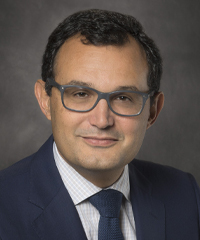Uncategorized
Myelodysplastic Syndrome & Acute Myeloid Leukemia
Unmet Needs and Current Challenges in MDS and AML Management
Overview
The development of novel therapies and combination regimens for patients with myelodysplastic syndrome (MDS) and acute myeloid leukemia (AML) have improved response rates, but current therapies are still considered suboptimal in high-risk patients. Addressing specific challenges that clinicians and patients face may help to improve treatment strategies for this population.
How do researchers and clinicians hope to advance the knowledge base, overcome current obstacles, and expand the treatment armamentarium?
David Sallman, MD
|
|
“Once we identify the patient subsets that are likely to respond to immunotherapy, we can design focused trials with novel immune checkpoint inhibitors to promote synergy with combination regimens and, subsequently, improve outcomes.”
Patients with high-risk MDS (HR-MDS) and AML who have TP53 mutations have dismal outcomes with standard therapy. We have also discovered that complete remission rates may not accurately represent disease response in this subset of patients. For example, a hypomethylating agent (HMA) plus venetoclax improves composite complete remission rates, but these responses are not durable, as patients still relapse and many do not survive past 6 months. Therefore, I think that event-driven trials are the direction of the future.
The premise of many exciting ongoing clinical trials is based on targets that are upregulated by HMAs. For example, azacitidine upregulates pro–“eat me” signals for synergy with CD47-targeted therapy. However, combination trials with traditional immune checkpoints, despite the upregulation of PD-1, PD-L1, and CTLA-4, have not shown synergism and have caused immune-related adverse events. Therefore, we must remain cautious when assuming that combination regimens based on the upregulation of checkpoint proteins will translate to improved responses or if synergy is via alternative mechanisms.
Another concern is that immunotherapy may not be effective in all patients due to critical differential effects on T cells, regulatory T cells, and myeloid-derived suppressor cells, as well as the leukemic stem cells’ interaction with the immune microenvironment. Once we identify the patient subsets that are likely to respond to immunotherapy, we can design focused trials with novel immune checkpoint inhibitors to promote synergy with combination regimens and, subsequently, improve outcomes. This may be particularly relevant in the relapsed/refractory setting.
Harry Paul Erba, MD, PhD
|
|
“Partnering with academic institutions that are experienced with novel therapies would allow patients to receive treatment close to home while also benefiting from the advice of clinicians who have used these regimens effectively and safely.”
One of the current challenges that we face is the difficulty replicating results from well-designed clinical trials in the real-world setting. Patients may not fit the stringent eligibility criteria used in clinical trials or they may not be as committed to therapy as those enrolled in clinical trials. Furthermore, clinicians may not have the experience to manage the toxicities associated with these therapies. In my opinion, partnering with academic institutions that are experienced with novel therapies would allow patients to receive treatment close to home while also benefiting from the advice of clinicians who have used these regimens effectively and safely.
Another important issue is ensuring the correct administration of azacitidine plus venetoclax. Often, the first cycle of azacitidine is initiated while waiting for prior authorization and co-payment assistance for venetoclax. That, of course, does not happen in the clinical trial setting, and the resulting delay in venetoclax administration may prevent the synergy that occurs when these 2 drugs are administered concurrently. In fact, one of the most surprising discoveries related to this combination regimen is the incredible synergy that is observed with 2 agents that are quite underwhelming as single agents.
Another challenge that many clinicians face is managing the toxicities associated with venetoclax, specifically myelosuppression. In the clinical trial setting, a bone marrow biopsy was performed between days 21 and 28 of cycle 1, and venetoclax was interrupted between cycles for recovery of blood counts after clearance of leukemia from the bone marrow (ie, counts <5%). However, in the real-world setting, clinicians are trained to administer HMAs for 3 to 4 cycles until a response is achieved, regardless of cytopenia. Consequently, patients continue to receive venetoclax for 28 days and they start the next cycle through cytopenia, contributing to the deaths due to neutropenia. However, the median time to respond with this combination regimen is 1 to 2 cycles, with most occurring during the first month. Therefore, we now decrease the duration of venetoclax from 28 days to 21, 14, or even 7 days, depending on the depth and duration of myelosuppression.
Guillermo Garcia-Manero, MD
|
|
“Although age and comorbidities may limit the available options for treatment, clinical trials may offer additional opportunities. So, I think that we need to improve the perception of investigational treatments and encourage eligible patients to consider enrolling in clinical trials.”
HMA failure is one of the significant problems that we face when treating patients with HR-MDS. While we are beginning to see improved response rates with doublets, we still lack a proper understanding of the molecular mechanism for primary and secondary resistance to HMA therapy.
Another challenge is that most patients with HR-MDS and AML may not be candidates for allogeneic stem cell transplantation due to age or comorbidities. Although age and comorbidities may limit the available options for treatment, clinical trials may offer additional opportunities. So, I think that we need to improve the perception of investigational treatments and encourage eligible patients to consider enrolling in clinical trials. The reality is that most patients understand that their prognosis is poor because currently available therapies are suboptimal. However, ongoing research with novel low-intensity regimens may improve outcomes in many patients who have not had treatment choices in the past.
References
DiNardo CD, Jonas BA, Pullarkat V, et al. Azacitidine and venetoclax in previously untreated acute myeloid leukemia. N Engl J Med. 2020;383(7):617-629. doi:10.1056/NEJMoa2012971
Jonas BA, Pollyea DA. How we use venetoclax with hypomethylating agents for the treatment of newly diagnosed patients with acute myeloid leukemia. Leukemia. 2019;33(12):2795-2804. doi:10.1038/s41375-019-0612-8
Richard-Carpentier G, DiNardo CD. Venetoclax for the treatment of newly diagnosed acute myeloid leukemia in patients who are ineligible for intensive chemotherapy. Ther Adv Hematol. 2019;10:2040620719882822. doi:10.1177/2040620719882822
Scott BL. Existing agents, novel agents, or transplantation for high-risk MDS. Hematology Am Soc Hematol Educ Program. 2020;2020(1):411-417. doi:10.1182/hematology.2020000125
Short NJ, Konopleva M, Kadia TM, et al. Advances in the treatment of acute myeloid leukemia: new drugs and new challenges. Cancer Discov. 2020;10(4):506-525. doi:10.1158/2159-8290.CD-19-1011
Tiong IS, Wei AH. New drugs creating new challenges in acute myeloid leukemia. Genes Chromosomes Cancer. 2019;58(12):903-914. doi:10.1002/gcc.22750
Winters AC, Gutman JA, Purev E, et al. Real-world experience of venetoclax with azacitidine for untreated patients with acute myeloid leukemia. Blood Adv. 2019;3(20):2911-2919. doi:10.1182/bloodadvances.2019000243













